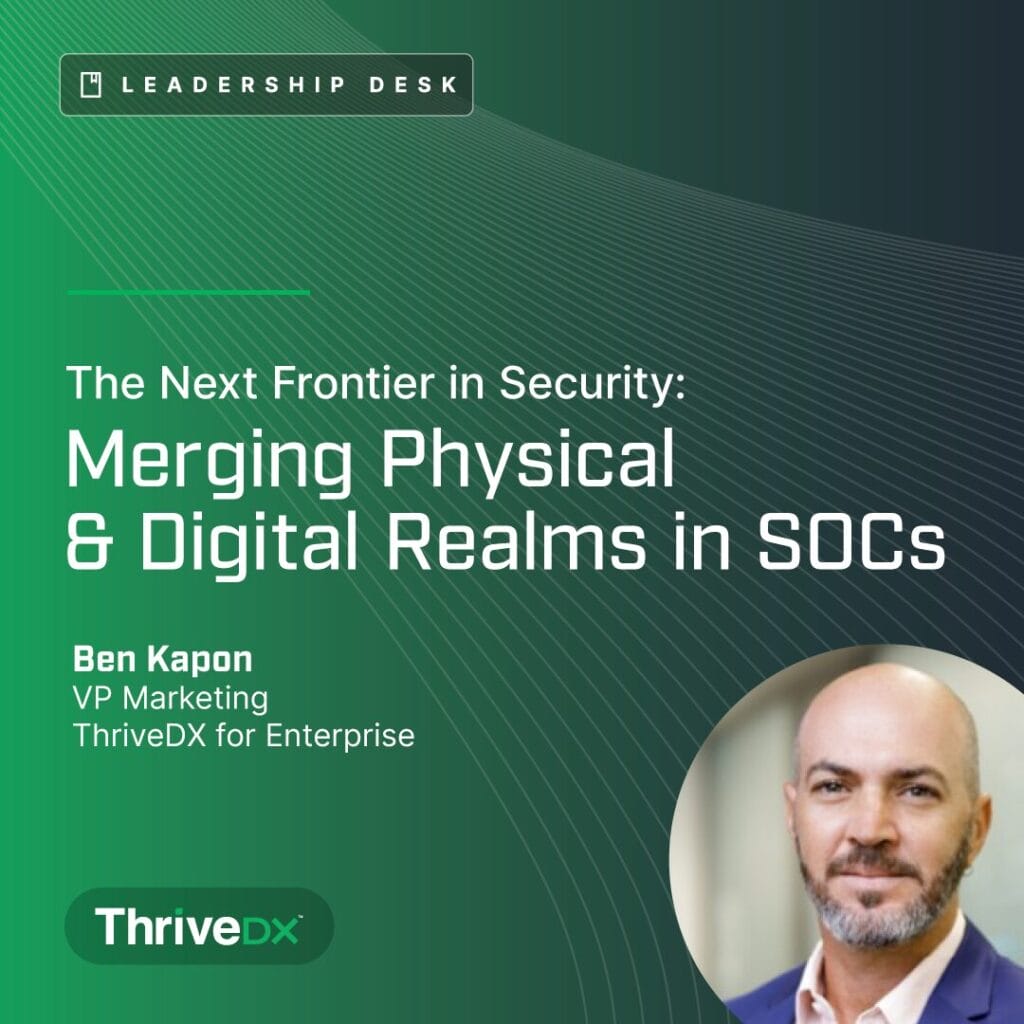- Ben Kapon, VP Marketing, ThriveDX for Enterprise
As 2024 approaches, we are witnessing a seismic shift in the landscape of security, marking one of the most rapid transformations in the nature of threats and defense strategies. The traditional notion that physical and digital threats occur in parallel universes without affecting each other is increasingly being proven wrong. This evolving landscape is exposing businesses of all sizes to a new type of coordinated attacks, where the lines between physical and digital security are not just blurred but often intersect, leading to complex and multifaceted security challenges.
On a global scale, we are witnessing these evolving threats firsthand. In 2022, the war between Russia and Ukraine quickly extended beyond traditional battle lines to include what some experts have called the largest military conflict of the cyber age. More recently, in October of 2023, when Hamas launched an attack against Israeli cities, a second digital war front quickly opened where Distributed-Denial-of-service (DDos) attacks were used to disable citizen alert systems and even humanitarian aid websites.
It’s a stark reminder that the lines between physical and digital security are becoming increasingly blurred. When threat actors seek to breach a physical parameter, a cyberattack usually follows soon after. It’s changing the way that Security Operation Centers (SOCs) need to operate, combining physical security with digital protection. As we approach 2024, we’re set to witness a paradigm shift in the way that we safeguard assets.
The Modern Physical Security Landscape
Physical security measures have progressed in leaps and bounds in the past decade, thanks in large part to new technologies and AI. Guard gates and surveillance cameras are now a first line of defense, reinforced with smart cards, biometric sensors and facial detection technology. This evolution has transformed the way that Security Operation Centers (SOCs) operate. Traditionally tasked with simply visually monitoring a physical space, SOC employees are now in charge of analyzing vast amounts of digital data and intelligence, and are expected to be adept at harnessing the power of AI and advanced analytics to detect potential security breaches. This is leading to a technological integration where both physical and digital security teams can better collaborate, drawing on all of their skills and resources to prevent attacks.
The Convergence of Physical and Digital Vulnerabilities
In the world of security, vulnerabilities often lie at the intersection of the physical and digital world. Threat actors are adept at exploiting the weakest link in the security chain, and understanding this is crucial to creating a robust security defense strategy that addresses all vulnerabilities – both physical and digital. The connection between both is becoming hard to avoid.
Consider, for example, a scenario involving two separate system events, monitored by different personnel. The facial recognition systems in a server room log an event of unauthorized access. At the same time, in the network control center, there’s a logged event of a configuration change. While these incidents are monitored independently, their simultaneous occurrence and the nature of the events raise suspicions of wiretapping.
"When threat actors seek to breach a physical parameter, a cyberattack usually follows soon after. It’s changing the way that Security Operation Centers (SOCs) need to operate."
Creating a Holistic Security Approach
Combining physical and digital security tactics to create a holistic approach to overall enterprise security has significant advantages. First, by breaking down the silos between physical and digital data, security professionals can seamlessly share information and gain a more comprehensive view of overall risks while minimizing the impact of attacks. Imagine when a high-capacity computing center falls victim to a crypto mining attack, causing it causes massive degradation in performance (and money). Anomaly detection begins when a temperature sensor in the server room registers abnormal heat levels. Initially, this might suggest a malfunctioning HVAC system. However, by cross-referencing this physical data with network activity logs and CPU or GPU utilization, security teams uncover a different story. This enhances the accuracy of threat detection, reduces false positive threats and ensures that security responses are targeted and effective. This collaborative approach is especially beneficial when responding to the complex and multifaceted modern cyberattacks that often span the physical and digital realms.
Challenges in Embracing Human-Centric Security Design and Workforce Development
While the benefits of combining physical and digital security are evident, challenges in bridging the gap persist. Many organizations still depend on outdated infrastructure, and integrating these with modern digital measures requires not only financial investment but also careful, strategic planning
Training and upskilling SOC personnel remain key challenges. Traditional security professionals may lack digital threat expertise, while digital security experts might not fully grasp physical security nuances. This is where Gartner’s concept of Human-Centric Security Design becomes crucial. It focuses on creating security solutions that are intuitive and aligned with the user’s needs and experiences, thus reducing friction and enhancing efficacy
To effectively navigate these challenges, companies are increasingly recognizing the value of partnering with specialized training providers. These partnerships can offer up-to-date training, workshops, and certifications, focusing not only on imparting necessary skills but also on the retention and ongoing development of security teams. Such collaborations enable organizations to provide current and comprehensive training, ensuring that their workforce is well-equipped to handle the complexities of an integrated security environment.
Rethink Cyber Hiring for Integrated Security
With the growing demand for skills in both physical and digital security, it’s crucial for organizations to rethink their hiring strategies. Beyond traditional methods, it’s important to consider partnerships with training providers who can offer customized training solutions tailored to specific organizational needs. These bespoke training programs ensure that the workforce is not only skilled but also aligned with the unique security challenges and objectives of the organization.
Moreover, collaborating with diverse training providers can open the doors to a more varied talent pool. This diversity brings different perspectives and approaches, enriching the problem-solving capabilities and innovation within the security team. Such an inclusive strategy not only enhances the skill set but also fosters a broader understanding of varied security scenarios, making the team more adaptable and robust in facing the dynamic challenges of today’s integrated security environment.
Innovations Driving the Convergence
In recent years, Artificial Intelligence (AI) and machine learning have emerged to play a pivotal role in both physical and digital security. Machine learning algorithms can analyze vast amounts of data quickly to identify patterns, changes and potential threats which is essential to responding to security threats in real-time. Additionally, AI-driven automation streamlines routine security tasks, enabling security professionals to focus on more complex tasks. Furthermore, Internet of Things (IoT) devices are bridging the physical-digital divide by creating a network of interconnected sensors and systems that contribute to a more responsive and adaptive security infrastructure. These technologies create an environment where physical and digital security teams can better collaborate.
"With the growing demand for skills in both physical and digital security, it’s crucial for organizations to rethink their hiring strategies."
Strengthening the Existing SOC for Dual Threats
Integrating digital threat monitoring into traditional SOCs requires adopting best practices that leverage the strengths of both domains. Continuous technological upgrades and the sharing of threat intelligence between teams are paramount in maintaining robust security. As threats are ever-evolving, so must our security measures.
Broader Implications for Businesses and Society
The repercussions of disjointed security measures extend beyond the immediate threat landscape. From a business standpoint, the economic and reputational risks associated with fragmented security measures cannot be overstated. When a company’s security framework lacks integration, it becomes vulnerable to sophisticated cyber threats, potentially resulting in financial losses, data breaches, and damage to its reputation. In an era where trust and credibility are paramount for business success, a disjointed security approach can erode customer trust and investor confidence. Moreover, the societal impact of inadequate security measures reaches far beyond the corporate realm.
As technology continues to play an integral role in daily life, the repercussions of security vulnerabilities become increasingly pervasive. A cyberattack on a business can easily extend to a breach of an employee’s private data, and vice versa. Ensuring the safety and privacy of individuals is a collective responsibility that extends beyond corporate interests.
It’s also important to take into account the responsible use of emerging security technologies. In crafting an integrated security strategy, businesses must prioritize the ethical use of technologies, fostering a culture of responsibility and accountability. This includes transparent communication with stakeholders about the measures in place, ensuring that security practices align with corporate values, and actively engaging in ethical decision-making processes. By placing the protection of individual privacy at the forefront, businesses can contribute to a more secure and trustworthy digital environment.
Moving Forward
The year 2024 signals a turning point in the world of security, where the integration of physical and digital defenses is not just a trend but a necessity. Companies must recognize and address the intertwined nature of physical and digital threats to safeguard their assets effectively.
As we move forward, the vision is clear: integrated security should become the norm, not the exception. By embracing this evolution and ensuring that both physical and digital security teams are cross-trained, businesses can build a resilient defense against the ever-evolving landscape of security threats, ensuring a safer and more secure future for all.

Ben Kapon has held leadership positions over the last decade in multiple startups and public companies, such as Check Point, Cognyte, Cylus, and Ionix. With a track record of driving product and strategy positioning, Ben’s expertise spans diverse industries, including national intelligence, Threat Intelligence, network, endpoint, OT, and cloud security, as well as cyber offensive solutions.
Protect Your Organization from Phishing
Explore More Resources
- Article, News
- Article, News
- Article, News
- Article, Blog
Your Trusted Source for Cyber Education
Sign up for ThriveDX's quarterly newsletter to receive information on the latest cybersecurity trends, expert takes, security news, and free resources.


